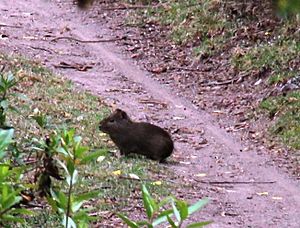Montane guinea pig facts for kids
Quick facts for kids Montane guinea pig |
|
|---|---|
 |
|
| Conservation status | |
| Scientific classification |
The montane guinea pig (Cavia tschudii) is a type of rodent that lives in the wild. You can find these animals in the Andes mountains of South America. This guinea pig is probably the main ancestor of the common pet guinea pig, also known as the domestic cavy (Cavia porcellus). Pet guinea pigs seem to be a mix of the montane guinea pig and other Cavia species.
About the Montane Guinea Pig
The montane guinea pig is a medium-sized animal. It can grow to be about 247 mm (9.7 in) long. Their fur color changes depending on where they live.
- In Peru, their back fur is a dark reddish-brown mixed with black. Their bellies are a dark buffy-grey.
- In Chile, their back is a pale agouti brown, with lighter fur underneath.
- In Bolivia, their upper parts are an agouti olive color. Their bellies are creamy-white or white.
Where They Live and Their Home
The montane guinea pig is native to the high Andes mountains in South America. Their home range stretches from Peru south into the Tarapacá Region of Chile. It also goes into the Tucumán Province of Argentina.
These guinea pigs live at very high altitudes. They can be found from 2,000 to 3,800 metres (6,600 to 12,500 ft) above sea level. They prefer wet places that have rocks and thick plants. They create pathways through the plants they live in. In Argentina, they make burrows, which are underground homes with several entrances.
Life Cycle
Female montane guinea pigs are pregnant for about 63 days. When they give birth, they usually have one to four babies. The young guinea pigs grow very quickly. They become independent and can live on their own when they are about 2 months old.
See also
 In Spanish: Poronccoy para niños
In Spanish: Poronccoy para niños


